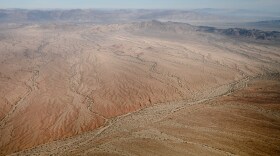—“Our Man in Tehran,” a FRONTLINE Series with The New York Times’ Thomas Erdbrink, Gives a Rare and Revealing Look at Life in Iran—
This summer, as tensions rise between the United States and Iran, with threats of war and sanctions, FRONTLINE is presenting an unusual and surprising portrait of life inside the Islamic Republic.
For 17 years, Thomas Erdbrink has been covering front-page news from inside Iran. Now chief correspondent and Tehran bureau chief for The New York Times, he is one of the last Western journalists living in the country.
Over the course of four years beginning in 2014, he was able to get permission to travel with a crew from Dutch television around the country, meeting people and hearing stories about their lives and hopes and fears, in one of the most isolated countries in the world.
Erdbrink’s rare and fascinating account comes to PBS on Monday, August 13, and Tuesday, August 14, when FRONTLINE presents “Our Man in Tehran” – a two-night, four-hour journey into the private world of Iran, revealing the people and the country in a way never before seen on U.S. television.
Curiosity brought Erdbrink, a young Dutch journalist, to Iran. There, at a gathering to witness the last solar eclipse of the 20th century, he met a young Iranian photographer, Newsha Tavakolian. They met again in 2001, fell in love and married, and have lived in Tehran ever since.
Knowing his way around, speaking Persian, and with unprecedented filming access, Erdbrink starts his journey with his Iranian friends and family, who are his introduction to the culture.
The film widens out into his daily life as a reporter, watching and listening as Iran goes through a rollercoaster of changes, with a modernizing society increasingly pitted against ideologically conservative Muslim clerics.
He’s on the phone as a friend and colleague is arrested and jailed; and reporting as the promise of the nuclear deal and the hope for relief from international sanctions comes up against new realities in Washington. He is shocked to hear of the arrest and death of a friend in prison, and struggles with the consequences as the family decides to leave the country.
Along the way, the series introduces a range of characters who try to live their daily lives in a country ruled by Koranic guidelines.
Somayeh, his assistant at The New York Times, comes from a deeply conservative family in the countryside, but now, as a newly divorced single woman in Tehran, encounters prejudice and sexism. Her frustration with the rules helps her decide to leave for America. Three years later, after a graduate degree in journalism at Columbia, she’s drawn back towards Iran, with all its problems.
This passion among exiles for the land they’re still attached to, is matched by the warmth and openness of the people Erdbrink finds. “I wanted to show viewers the Iran I’ve come to know, sharing the stories of how people live their lives — both inside and just outside the system,” he says.

It’s a view of Iranian society that will both surprise and intrigue viewers — inside a 12-step AA meeting in a country where drinking alcohol is banned; following a young woman who decides to challenge the compulsory Islamic headscarf law; experiencing the explosive popularity of Instagram among a new generation of Iranians; or meeting a volunteer soldier who has just come back from multiple tours in Iraq and Syria and talks about martyrdom with his wife and young children nearby.
Whether confronting the government, dogmatically defending it, or just trying to enjoy their lives, the Iranians in Erdbrink’s encounters are often very different than viewers in the United States might expect them to be.
Behind the personal stories, "Our Man In Tehran" offers a serious look at whether this important country can open up to the world — and explores how its leaders’ harsh rhetoric against America often differs from the beliefs of ordinary Iranians.
The series sheds light on how, since the 1979 revolution, the U.S. has remained the Iranian government’s number-one scapegoat, and is blamed for just about everything that goes wrong in the country.
Yet, as “Our Man in Tehran” explores, many ordinary Iranians dream of coming to America. Others have risen up in recent years, speaking out against their government about economic inequality, the religious police, and more.
And it’s all taking place against the backdrop of a drought that even some Iranian officials say is a much bigger problem than Iran’s enemies abroad.
Our Man In Tehran video series
Watch the related video series on nytimes.com
Director Roel van Broekhoven and Thomas Erdbrink have made an intimate and revealing portrait of the country. “'Our Man in Tehran' is a must-watch television event for any American wanting to understand Iran,” says FRONTLINE founder David Fanning, who is a senior producer of the series. “More than ever we need to get behind the rhetoric and the headlines to see the country in its depth and humanity.”
WATCH ON YOUR SCHEDULE:
Episodes of FRONTLINE become available for streaming on demand at pbs.org/frontline during each broadcast.
JOIN THE CONVERSATION:
Follow @ThomasErdbrink on Twitter.
FRONTLINE is on Facebook, Instagram, tumblr, and you can follow @frontlinepbs on Twitter. #frontlinePBS
CREDITS:
A production of VPRO Television, The Netherlands, with Phanta Film for FRONTLINE in association with The New York Times. The writer and director is Roel van Broekhoven. The correspondent is Thomas Erdbrink. The senior producer for VPRO is Nicole Prints. The senior producer is FRONTLINE executive producer at large David Fanning. The executive producer of FRONTLINE is Raney Aronson-Rath.





